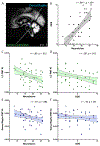Locus coeruleus catecholamines link neuroticism and vulnerability to tau pathology in aging
- PMID: 36191755
- PMCID: PMC10060440
- DOI: 10.1016/j.neuroimage.2022.119658
Locus coeruleus catecholamines link neuroticism and vulnerability to tau pathology in aging
Abstract
Higher neuroticism is a risk factor for Alzheimer's disease (AD), and is implicated in disordered stress responses. The locus coeruleus (LC)-catecholamine system is activated during perceived threat and is a centerpiece of developing models of the pathophysiology of AD, as it is the first brain region to develop abnormal tau. We examined relationships among the "Big 5" personality traits, LC catecholamine synthesis capacity measured with [18F]Fluoro-m-tyrosine PET, and tau burden measured with [18F]Flortaucipir PET in cognitively normal older adults (n = 47). β-amyloid (Aβ) status was determined using [11C]Pittsburgh compound B PET (n = 14 Aβ positive). Lower LC catecholamine synthesis capacity was associated with higher neuroticism, more depressive symptoms as measured by the Geriatric Depression Scale, and higher amygdala tau-PET binding. Exploratory analyses with other personality traits revealed that low trait conscientiousness was also related to both lower LC catecholamine synthesis capacity, and more depressive symptoms. A significant indirect path linked both high neuroticism and low conscientiousness to greater amygdala tau burden via their mutual association with low LC catecholamine synthesis capacity. Together, these findings reveal LC catecholamine synthesis capacity to be a promising marker of affective health and pathology burden in aging, and identifies candidate neurobiological mechanisms for the effect of personality on increased vulnerability to dementia.
Keywords: Aging; Conscientiousness; Locus coeruleus; Neuroticism; Tau.
Copyright © 2022. Published by Elsevier Inc.
Conflict of interest statement
Declaration of Competing Interest Dr. Jagust has served as a consultant to Biogen and Bioclinica, and holds an equity interest in Optoceutics. All other authors have no financial disclosures.
Figures





References
-
- Abiose O, Deters KD, Young C, Mormino EC, 2020. Amygdala tau in preclinical Alzheimer’s disease. Alzheimer’s Dement. 16 (S4), e046762. doi:10.1002/alz.046762. - DOI
-
- Arenaza-Urquijo EM, Przybelski SA, MacHulda MM, Knopman DS, Lowe VJ, Mielke MM, Reddy AL, Geda YE, Jack CR, Petersen RC, Vemuri P, 2020. Better stress coping associated with lower tau in amyloid-positive cognitively unimpaired older adults. Neurology 94 (15), E1571–E1579. doi:10.1212/WNL.0000000000008979. - DOI - PMC - PubMed
-
- Bachman Shelby L., Cole Steve, Yoo Hyun Joo, Nashiro Kaoru, Min Jungwon, Mercer Noah, Nasseri Padideh, Thayer Julian F., Lehrer Paul, Mather Mara, 2022. Daily heart rate variability biofeedback training decreases locus coeruleus MRI contrast in younger adults. medRxiv doi:10.1101/2022.02.04.22270468. - DOI - PMC - PubMed

